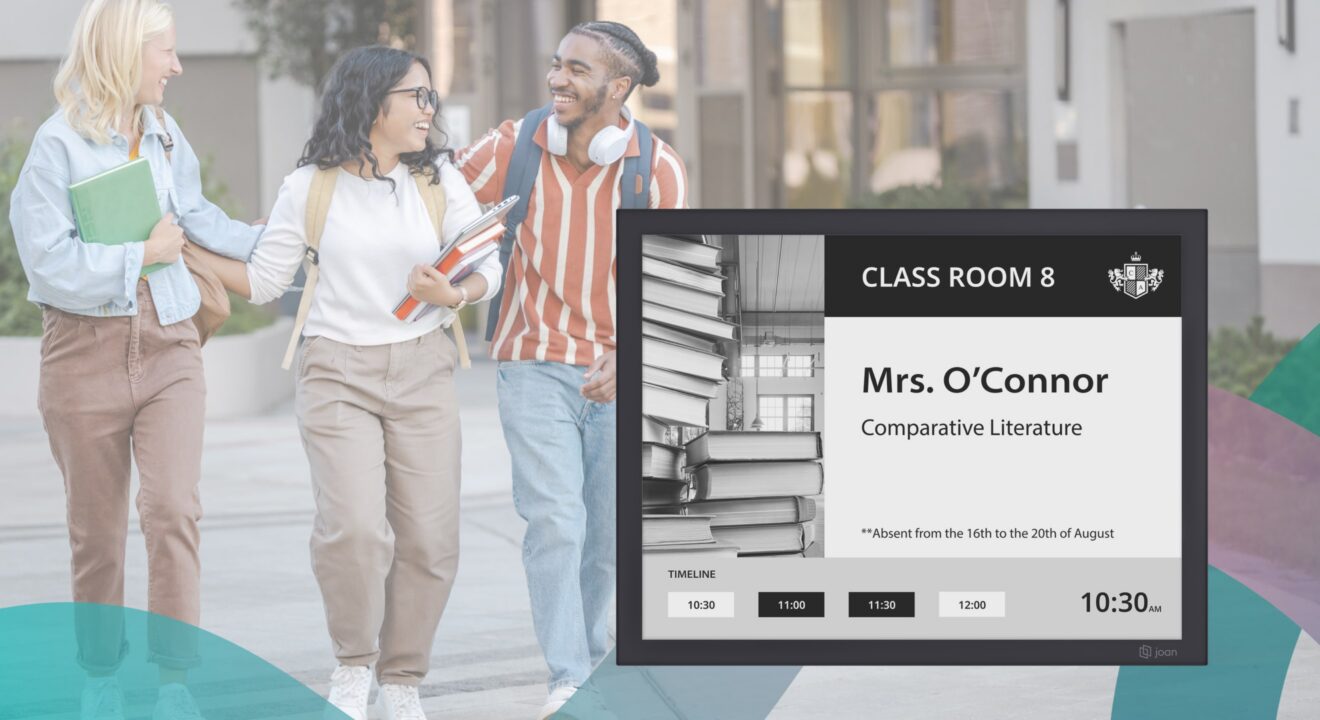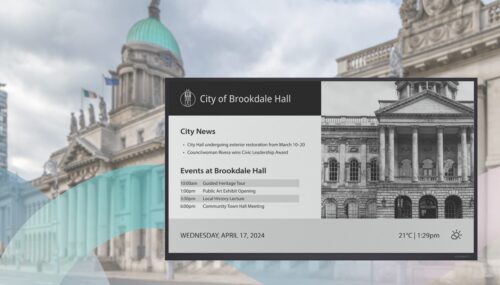

The best digital signage for universities
Visionect, 21 Oct 2025
Universities are dynamic spaces where communication is constant, from class updates to event reminders and safety alerts. Yet bright, flashy screens can disrupt the calm and focus that campuses value. More institutions are turning to energy-efficient digital signage that shares information clearly without creating visual noise.
In this article, we’ll explore how subtler digital signage helps universities modernize communication, improve organization, and create a more connected campus experience.
The communication overload on campus
Imagine your campus as a living organism: messages are its bloodstream. But when every department circulates its own signals—posters, slides, emails, banners—the system becomes clogged. Digital signage centralizes that flow, creating one clear channel for critical messages, event notices, class schedules, alerts, and navigation.
Trends pushing adoption
Sustainability and energy budgets: As campuses commit to carbon reduction, low-energy e-paper signage is attractive. Universities like BOKU in Vienna have adopted e-paper displays to provide energy-efficient, centrally managed schedules across lecture halls and seminar rooms, demonstrating that sustainable signage can be both functional and elegant.
Hybrid learning and flexible use spaces: Classrooms are constantly being repurposed. A room that hosts a lecture in the morning might become a study space or event venue later in the day. Digital signage keeps up with these changes by updating schedules and room details in real time.
Accessible and easy to read: Centralised Content Management Systems (CMS) allows quick adjustments to font sizes, languages, or color contrasts, making information more inclusive. Interactive touchscreens can further improve accessibility by letting users navigate content in the way that suits them best.
Design integration: Many campuses feature historic or architecturally distinct buildings where drilling or wiring isn’t ideal. Plus, traditional screens can look bulky or out of place in these environments, while slim, paperlike, wireless displays maintain the building’s character.
How universities use digital signage: Use cases
Digital signage serves a wide range of purposes on campus, from sharing schedules and promoting events to guiding visitors and communicating urgent alerts.
Classroom & lecture schedule displays
Outside lecture halls, “room signage” displays show course titles, occupancy, and real-time changes. The University of Applied Sciences Northwestern Switzerland uses about 170 Visionect Place & Play devices (in sizes from 6″ to 32″) to display what’s happening in spaces, including capacity updates and QR links.
These displays eliminate the need for manually swapping printed signs and reduce confusion during last-minute room changes.
Wayfinding & campus maps
Large e-paper displays can act as digital campus maps, easing navigation for visitors, conference guests, or first-year students. Because e-paper signage requires no wiring and minimal energy, it can be placed in strategic spots such as entrances, lobbies, and junctions without causing aesthetic or infrastructure disruptions.
Event promotion & announcements
Whether guest lectures, performer recitals, or student club fairs… The event calendar is always shifting. Digital signage allows real-time updates and highlights priority events. For example, the Olympia School District uses e-paper displays to provide a glare-free, battery-powered solution that can also show general campus reminders.
Emergency alerts and safety messaging
In emergencies, timely messages are critical. Digital signage (especially in high-traffic zones) can dynamically switch to alert mode, display evacuation routes, or broadcast instructions until the situation clears.
Tracking performance across campus
Some universities host analytics dashboards on internal signage, displaying enrollment stats, safety metrics, or research highlights in staff lounges or administrative corridors. E-paper displays are ideal for semi-static dashboards because they can hold an image without using power and only need energy when the content changes.
Library & special collections use
Libraries call for the quietest kind of communication. E-paper digital signage shares collection details, exhibition notices, or directions without glare or glowing screens. Even historic libraries, like the National and University Library in Slovenia, show how modern communication can blend seamlessly into timeless spaces.
What to look for in university-friendly digital signage
Not all digital signage is equally suited to academic settings. Here are features worth insisting on:
| Feature | Why it matters in universities |
| Paperlike, non-reflective displays | To maintain visual harmony, avoid glare, and prevent multi-sensory distraction. |
| Wireless/no wiring installation | Many heritage buildings or glass walls resist drilling. Battery-powered or wireless units solve that. |
| Long battery life/ultra-low power use | Reduces maintenance burden—less frequent recharging or battery swaps. |
| Remote content management/cloud CMS | Facilitates updates from any location, without physical access or IT overhead. |
| Template flexibility/scheduling / divisions by department | Allows departments to own a “slice” of signage time without chaos. |
| Accessibility features | Toggle languages, high contrast mode, different font sizes, or alt text. |
| Hybrid content support (static + QR/dynamic links) | E-paper shows static content clearly and can link to videos or extra resources via QR codes. |
| Scalability and modular add-ons | So you can expand signage networks over time without redoing infrastructure. |
See how Place & Play CMS lets you update every screen remotely
Success factors and deployment tips
Effective digital signage requires careful planning, clear content, and collaboration with campus stakeholders to ensure it enhances communication without disruption.
Start small, pilot in high-impact zones
Start with a few key spots, like the main lobby, student center, or library entrances, and trial your digital signage. Keep an eye on how it’s used, tweak the content, and gather feedback.
Introducing signage to your campus
You don’t want signage to feel like a billboard in a library. It should be like a page in a campus journal, quietly present.
Content strategy matters
Keep displays simple and easy to read. Use a clear hierarchy with a headline, summary, and call-to-action or QR code, and rotate content like events, alerts, or daily tips while keeping the look consistent.
Connect to campus systems
Connect your signage to scheduling, room booking, emergency alerts, and directory systems so the information is always accurate and up to date.
Monitor energy and maintenance
Keep an eye on battery levels so you’re alerted before devices run out of power, and plan for regular maintenance and updates to keep the system running smoothly over time.
Involve stakeholders early
Include faculty, campus planning, facilities, IT, and student groups. A shared governance model helps avoid surprise objections (e.g., “That display covers the mural in the student lounge!”).
Looking ahead: trends and future opportunities
Interactivity + hybrid displays: QR codes or touch inputs let students dig deeper into listings, maps, or digital resources.
Mixed networks (e-paper + LED): Use e-paper for subtle, low-frequency updates; reserve LED panels for announcements needing video or motion.
AI-driven content rotation: Smart systems may optimize which announcements show at what time based on foot traffic, user interests, or context.
Sustainability scoring: As ESG (Environmental, Social, and Governance) becomes an institutional priority, low-power, minimal-waste signage could factor into annual sustainability reports.
Key takeaways: improving communication with campus signage
Universities are complex, evolving communications ecosystems. To manage them coherently, digital signage offers the chance to unify messaging, ease navigation, and declutter campus communication—without turning academic spaces into ad-fests. By choosing subtle, efficient signage (especially e-paper solutions that run months on a single battery charge), campuses can modernize their communication infrastructure while preserving their character.
Looking to modernize your campus signage while keeping spaces calm and cohesive? Let our team help you plan the right approach.
LET’S TALK ABOUT YOUR SPACE
